Lighthouse Keepers
1. Article About The History of the Knotts in the Lighthouse Service
2. Article about the Knott Family published in the magazine LAMP, published by the Association of Lighthouse Keepers.
George Knott
The image below shows George Knott with his model of Smeaton's tower in which he served from 1861 to 1865. The model was kept in the family for many years, owned by his grandson Fred Knott of Braunton (later Barnstaple) Devon. After a short hiatus on his death, the model was finally acquired by the National Maritime Museum which kept it in store for a number of years. After significant lobbying from pharologist Ken Trethewey, the model was found a home in the Maritime Museum at Chatham.
Finally, the model and George's contributions to serving at the Eddystone lighthouse have been properly recognized by the National Maritime museum. See this link for some images of the interiors of this magnificent model.
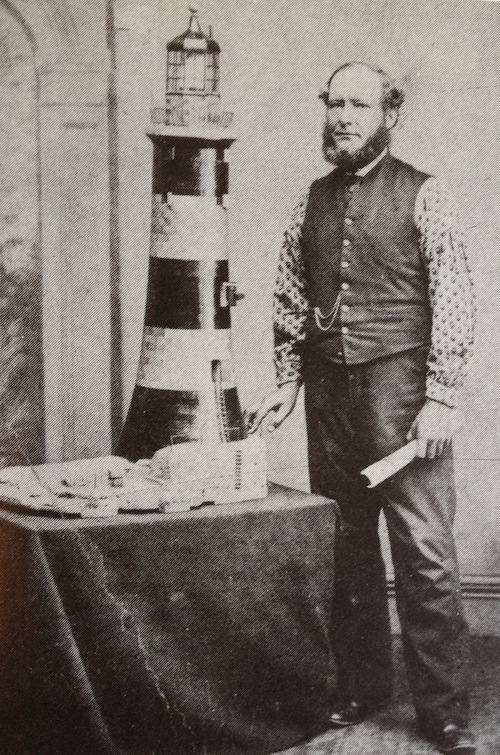
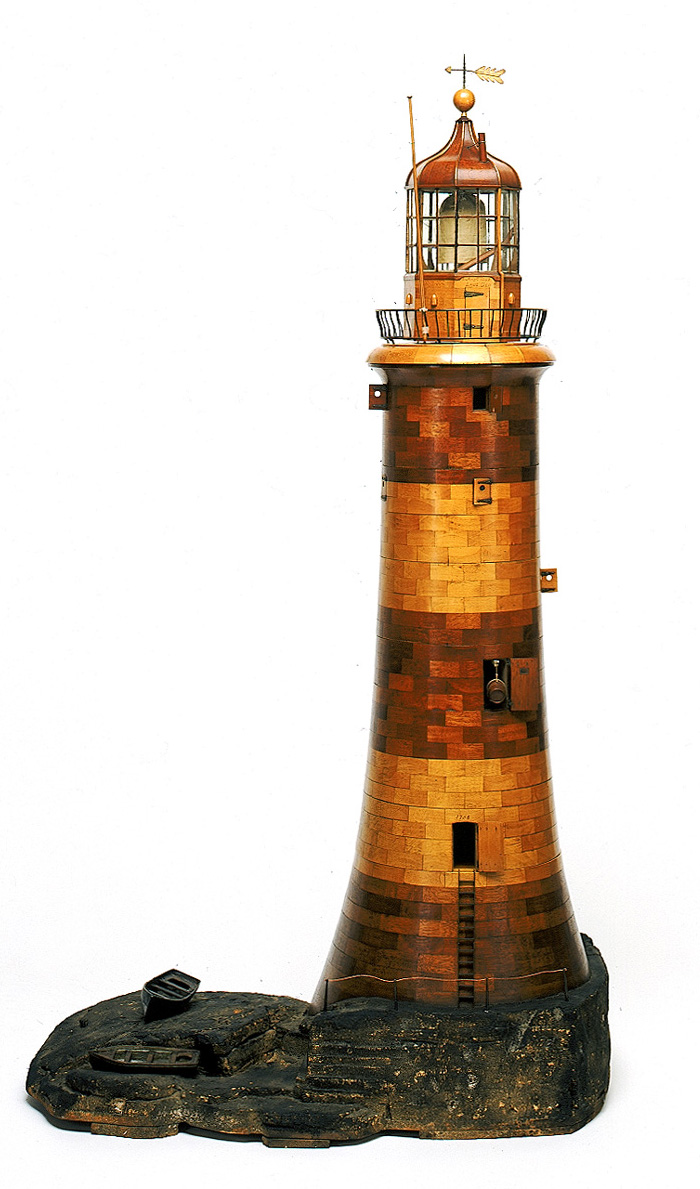
Other Models
1. North Foreland
George made models of the lighthouses in which he served and two others are still in existence.The model shown below is of the North Foreland from which he retired in 1904.
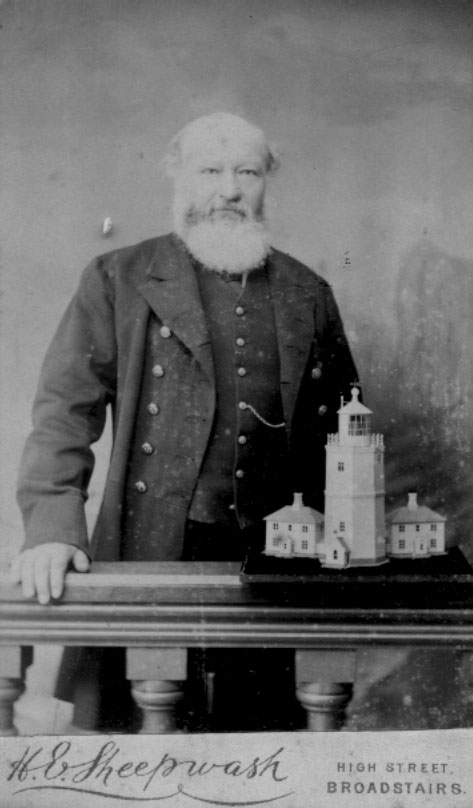
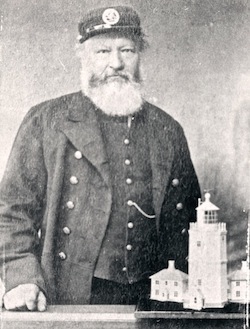
The image below shows the model as Ken Trethewey found it in the home of Frederick Herbert Knott of Barnstaple in 1977. Fred is on the right; his wife, Gwen is on the left. Centre is Chris Trethewey.
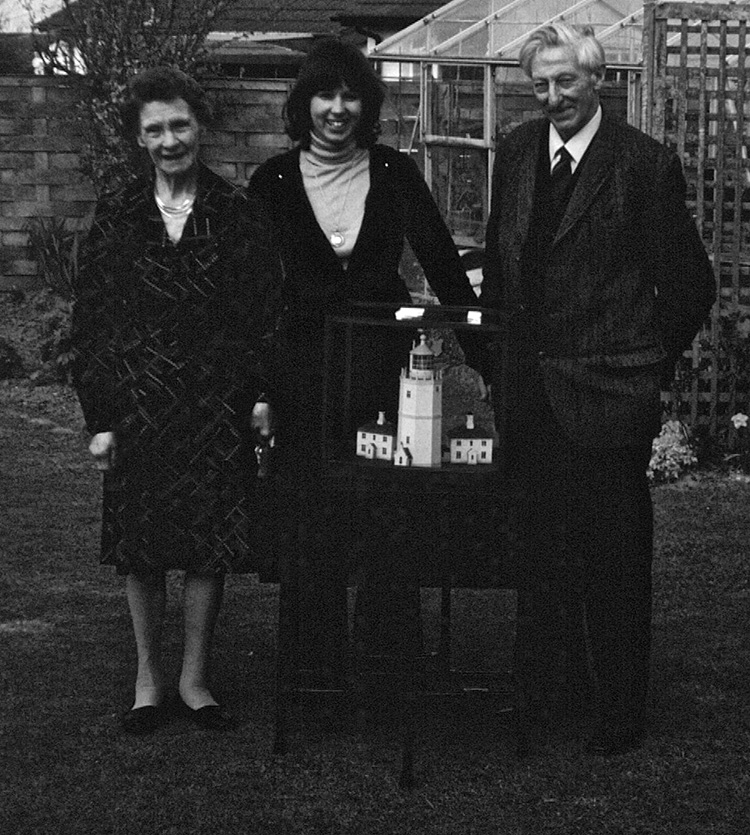
Below, a close-up of George's model of North Foreland lighthouse as found in 1977.
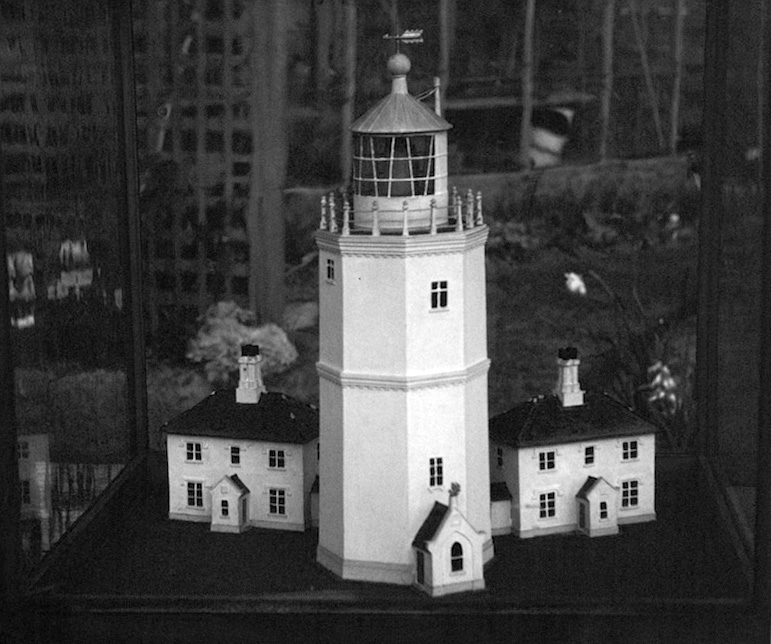
2. Bull Point
Below is the model he made of Bull Point lighthouse to which he was appointed as Principal keeper after it was first opened in 1879
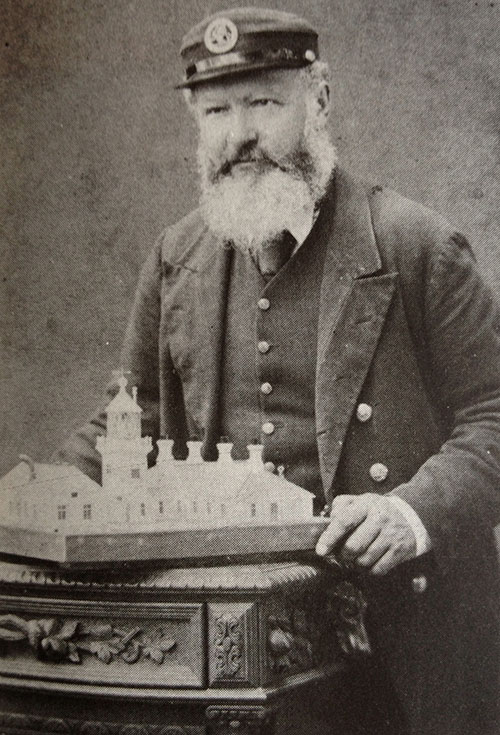
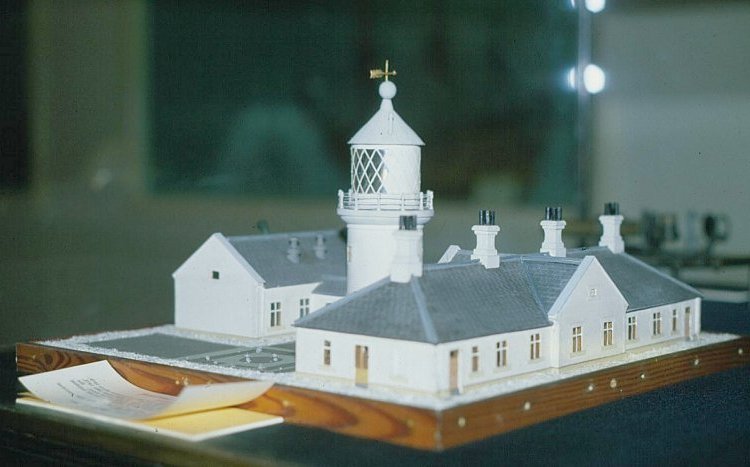
As a wonderful comparison with the model, the photo below shows George with his wife Catherine standing at the entrance to the lighthouse, probably sometime soon after his appointment there in 1879.
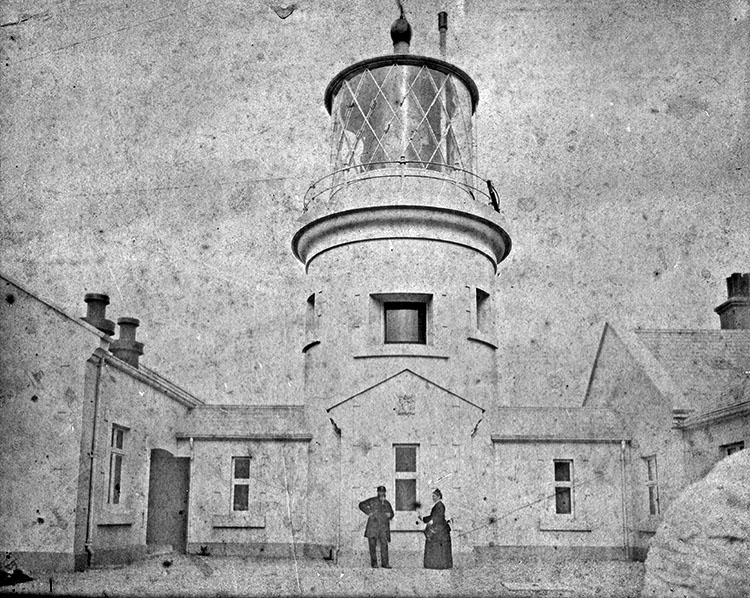
The following is an extract from the memoirs of Ken Trethewey
It soon became clear that the part of my family tree that related to lighthouse keepers was only partially known. There was a good reason for this. My great-great-grandfather and grandmother, George and Catherine Knott, had produced thirteen children over a large number of years. A key feature in the history of this family group was George’s move from the South Foreland lighthouse at Dover to the Smeaton Eddystone in 1861. It created a second focus for the family in the southwest of England after a long history of lighthouse keeping at South Foreland that up to that point had spanned 130 years. My own branch of the family thus grew up in Devon, knowing very little about the large residue of family that still remained in Kent.
After his appointment to the Eddystone, off the south Devon coast, George and Catherine moved to Braunton in north Devon, where they lived for many years in the wonderful Bideford lighthouse that was situated amongst the sand dunes several miles to the south of Braunton has been long since destroyed. There they continued to raise their large family. My great-grandfather, Frederick Warner Knott was born into this environment, grew up, married Helen Hill, the daughter of a master armourer in Devonport Dockyard, and brought up his own family in Braunton, of which my grandfather, Frederick Roland Knott (Rowley) was the eldest of five children. Then, when a new lighthouse was opened at nearby Bull Point in 1879, George took up an appointment there as Principal Keeper, with Catherine unofficially fulfilling the role of Assistant Keeper, a rare and forgotten example of how women acted as lighthouse keepers but received no recognition for their work. The direct connection with lighthouse keeping in my immediate family thus came to an end when eventually, Frederick Warner and his wife, Helen, moved to Plymouth in the early 1900s.
George and Catherine moved back to Kent where George took up his final appointment at North Foreland lighthouse until his retirement in 1904. Walter, a younger brother of Frederick Warner, remained in the Barnstaple area and his own son, also called Fred, was to become a good friend to me in the 1970s when I was trying to unravel much of this important family history.
The other distant relative who helped me a lot in my family researches, was Frederick Goldsack Knott (1891-1981), son of Walter Joseph Knott (b1866, Braunton). This Fred Knott should not be confused with my grandfather, who was his older cousin. My decision to meet him proved to be a key discovery in the history of George Knott and his fabulous models.
When I first knew him in the late 1960s, he was approaching his eighties and living with his younger, second wife, Gwen, in a delightful semi-detached home, on the main road to Barnstaple. Later, due to his great age, the couple moved to a more functional bungalow in a quieter location at 18 Home Farm Road, Fremington, not far from their earlier home. At first, it was my parents who took me to visit. We had located his address from amongst my grandfather’s papers and decided that here was a man who would have precious memories of the exact times we were interested in. He should be visited without delay.
Fred was one of those old men whose age had made no detrimental impact on his intellect. As sharp as a razor, he was as mentally active as men far younger than he. His memory was excellent, and he was a charming, friendly conversationalist keen to tell me as much as he knew about the lighthouse heritage of our common family, but always ready to ask questions about me too. Furthermore, he was in excellent physical shape, with a current driving licence and who could outpace many people half his age in a brisk walk. With his generous helping of silver hair and gently tanned features, he could easily have passed for someone ten years younger. His long-since relinquished profession was cabinetmaker. (I later understood from Mum that this was a euphemism for the trade of constructing, amongst other things, coffins.) Interestingly enough, the woodworking skills appeared to have passed down from George.
Fred’s house was generously filled with a significant collection of artefacts made by the method known as Cloisonné. I say, artefacts, because it was not restricted to tableware - plates, cups and saucers, for example, but to many kinds of objets d’art. Today, just one piece is worth a great deal of money, but even then it was clear that Fred had acquired a large collection of very high quality and value. We knew little about Cloisonné then and were privileged to be shown the pieces by this expert collector. It seemed almost insulting to change the subject and talk about lighthouses.
When we arrived on that first visit, sure enough, there in the corner of his kitchen was a fantastic model of the Smeaton tower, but this one was altogether different from the Bull Point model, for it was between three and four feet in height (90-120 cm) and could be completely dismantled. First, the lantern could be lifted off to display the lantern room. It had been built in sections that corresponded to the floor levels of the building. Each level lifted off to display the furniture and fittings of the room beneath, in the exact manner of any fine doll’s house. Magnificent. It appeared that the model had been constructed largely from wood of two colours, a dark hardwood and a lighter material that Fred assured me had been recovered from timbers washed up on the rocks at the foot of the lighthouse. (This effect had also been used successfully to make a chessboard, the light and dark woods forming the alternate white and black squares.) Then came the real shock – George had made two of these lighthouse models! Fred was able to tell us that there had indeed been an identical model in the entrance hall of Trinity House and that it had been lost forever. What a joy that Fred’s model remained, but we would never know whether it was the first or second version.
Over a period of several years, we corresponded, mostly about the trivialities of daily life. Then, later, when I had purchased a car of my own, Chris and I made one or two more visits to his bungalow home. Yet another surprise was in store, for Fred arranged for us to meet a relative who possessed a model of North Foreland lighthouse. Fortunately, it had been well cared for and was housed inside a purpose-built glass case. The lighthouse continues to reside in the care of a family member today.
A question that was never answered was whether there had been other models. There should have been one of South Foreland, the original family home, and you might have expected one of the wonderful Bideford lighthouse, but we have never come across any evidence to suggest that such models existed.
Fred died in October 1981, aged 90, and Gwen died a year later. Naturally, his lighthouse model was a family heirloom that was destined to pass to the eldest son, Douglas, rather than to some distant cousin (me) as I desperately hoped. It is not surprising in these circumstances that the delegated recipient had no desire to treasure such an item in the way that was required, preferring to realise its monetary value. The model was quickly sold to a dealer for an unknown price, and with great fortune, subsequently found its way into the possession of the National Maritime Museum at Greenwich. For a year or two, it was put on display as part of a general lighthouse exhibit, and then relegated to yet another storeroom. From about 2010, thanks to the efforts of another relative, Lorna Bailey, the model is now on display as part of the Historic Ships Museum at Chatham Dockyard.
For my part, I was absolutely delighted when Gwen Knott gave me some items from Fred’s lighthouse collection. To most people, they would have appeared valueless, but to me they were priceless. The first was an old dog-eared copy of a magazine that contained an article about the history of the Knotts in the lighthouse service. Of particular value were three old photos of George with his son and father, the last being unsurpassed in our family history. It could easily be the earliest photograph of a lighthouse keeper in uniform. The second item was an extremely battered copy of an old book summarising the correspondence between the participants in the building of the Smeaton Eddystone. In addition, I was given several old photographs of George and Catherine, including the fine photograph I referred to earlier of the couple standing in the courtyard at Bull Point lighthouse.